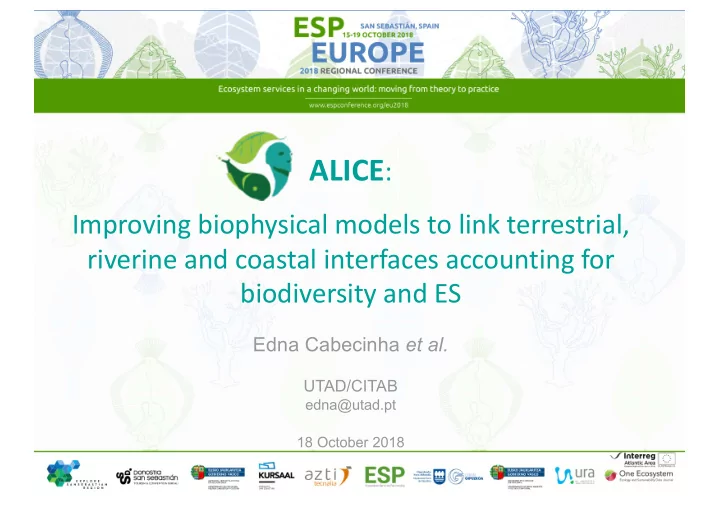

ALICE : Improving biophysical models to link terrestrial, riverine and coastal interfaces accounting for biodiversity and ES Edna Cabecinha et al. UTAD/CITAB edna@utad.pt 18 October 2018
Improving the management of Atlantic Landscapes accounting for bIodiversity and eCosystem sErvices KEY OBJECTIVES ü Develop a full-package of new methods, tools and procedures to assist with coastal and inland landscape management ü Targeting and stimulating BGI investment within the 4 CS by quantifying the benefits for ES including biodiversity conservation ü Identify solutions for the economic and social barriers , which may limit investment in BGI in each of the 4 CS ü Provide with stronger scientific and socioeconomic support for the effective implementation of future BGI and environmental policy.
CASE STUDIES Ireland / UK, Carlingford Lough France, Couesnon River Spain, Pas, Miera and Asón 4 CS 5 COUNTRIES Portugal, Paiva
ALICE Model Integration Popula'on Pressures Agriculture Climate change LULC change Industries Water uses Tourism MODELS Fires Conceptual model Model Biophysical models (Ecological, Integra:on Hydrological, etc…) BIODIVERSITY Cognitive mapping SH Aqua:c Biodiversity FORUM BGINs Terrestrial Biodiversity SH participatory Scenarios process Ecosystem Services Characterisation SH 4 Case studies FORUM PES & Barriers for GINs
STAKEHOLDER INVOLVEMENT
INTEGRATED MODELING SH FORUM Habitat mapping Mapping land cover SH (present) trends Participatory FORUM Mapping Par.cipatory Modelling future Assessing impact on Scenario Ecosystem LUCC trends biodiversity Services valuation River and Estuarine models
Climate StDM Simulation Hydrological Out put model model Biological and Environmental levels IPCC Scenarios Hydrology (SPHY) model Cellular Automata StDM model Land use dynamic level Stella 1995 2050… Image Simulation Scenarios Out put Virtual LULC model Watershed
INTEGRATED MODELING
CLIMATE MODELING I EURO-CORDEX ensemble simulations ü This methodology take in account the uncertainties associated with the design and parameterization of physical-mathematical climate models. ü 5 pairs of models are considered ü Regional climate models (RCMs) are coupled to global climate models (GCM), allowing a significant reduction of scale and an increase in spatial resolution of the study. Table 1. Lis<ng of model pairs (GCM-RCM) used in ALICE. GCM RCM CNRM-CERFACS-CNRM-CM5 CLMcom-CCLM4-8-17 CNRM-CERFACS-CNRM-CM5 SHMI-RCA4 MPI-M-MPI-ESM-LR CLMcom-CCLM4-8-17 ICHEC-EC-EARTH DMI-HIRHMA5 MPI-M-MPI-ESM-LR SHMI-RCA4 Data were subject to a bias correction performed under the previous project (SMHI-DBS45-MESAN, 1989-2010).
CLIMATE MODELING I ü Complementary scaling methodologies were applied, allowing the increase of the spa6al resolu6on of ~12 km to ~1 km in all variables. IPCC Scenario 4.5 IPCC Scenario 8.5
Climate River and Estuarine models LULC model projections • Hydrological models • Flood models • Water Temperature • Nutrients (NO 34 , PO 43 ) • Suspended solids • DOM • Ecological Status • Ecosystem Service Valuation Selected BGINs, Scenarios LULC • and analysis of trade-offs & Case Studies Habitat Maps • • Terrestrial and Aquatic R&E Ecosystem • Biodiversity Models Stakeholder ParScipaSon process Establishment of schemes for payment for ES and biodiversity conservation
ALICE TEAM Edna Cabecinha, Samantha Hugges, Rui Cortes, João Cabral Mário Santos, Simone Varandas, Luis Filipe Sanches, Fernando Pacheco, João Santos, André Fonseca, Martinho Lourenço, José Aranha, Domingos Lopes, João Paulo Moura, Diane Burgess, Cendrine Mony, Thomas Houet, Stefano Balbi, Ferdinando, Mariana Milagaia, Marco Magalhães, Johanna Beganton, Jose Alvarez-Martinez, Pepe Barquín
Thank you!! @aliceinterreg @ALICE_Interreg http://project-alice.com
Recommend
More recommend